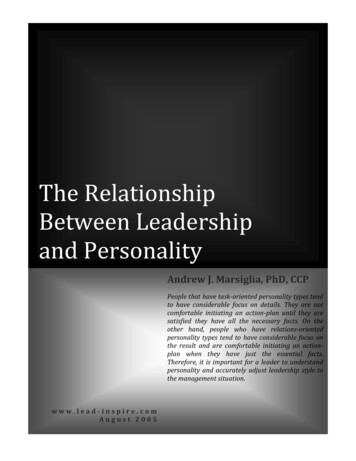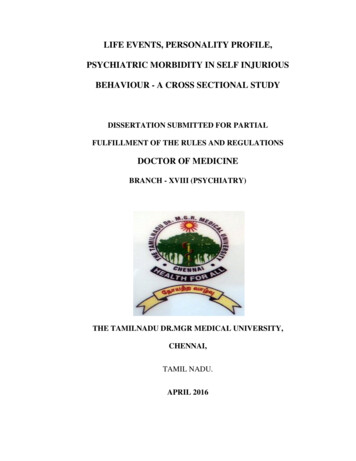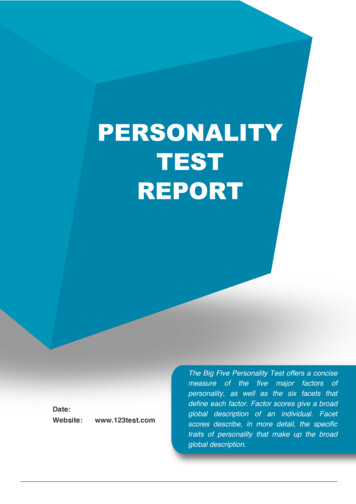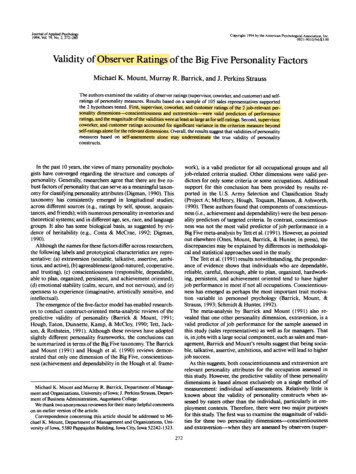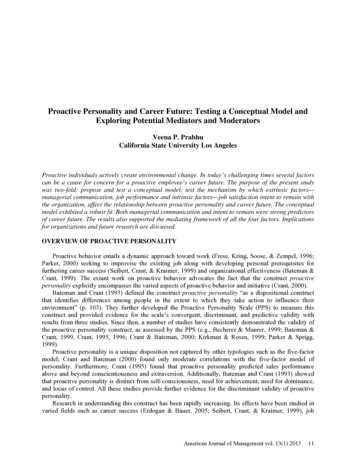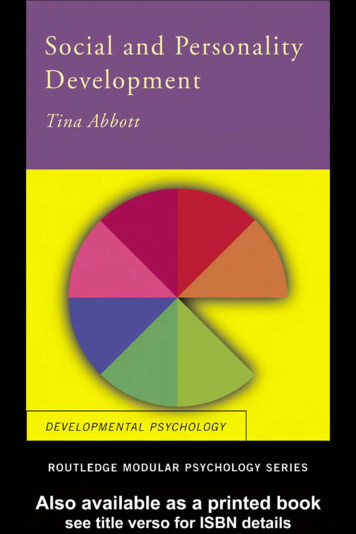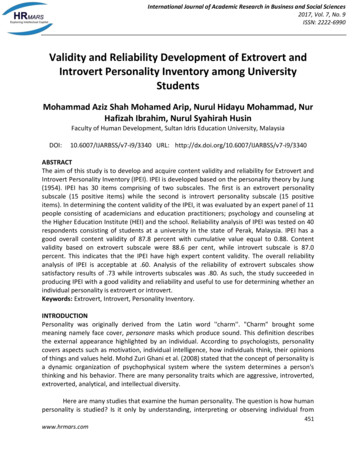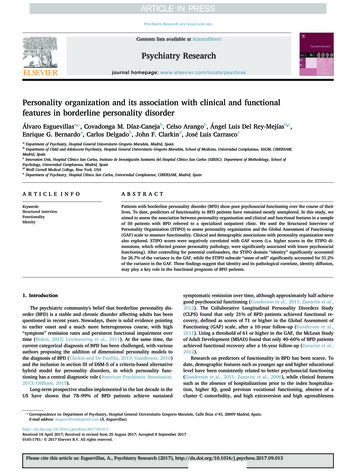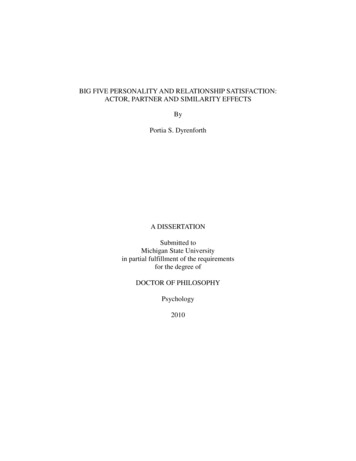
Transcription
BIG FIVE PERSONALITY AND RELATIONSHIP SATISFACTION:ACTOR, PARTNER AND SIMILARITY EFFECTSByPortia S. DyrenforthA DISSERTATIONSubmitted toMichigan State Universityin partial fulfillment of the requirementsfor the degree ofDOCTOR OF PHILOSOPHYPsychology2010
ABSTRACTBIG FIVE PERSONALITY AND RELATIONSHIP SATISFACTION:ACTOR, PARTNER AND SIMILARITY EFFECTSByPortia S. DyrenforthData from married couples in the United Kingdom (N 6,554), Australia (N 5,278),and the United Kingdom (N 11,418) were used to examine the intrapersonal and interpersonaleffects of personality on relationship and life satisfaction. The Actor-Partner InterdependenceModel (APIM; Kenny, Kashy, & Cook, 2006) was used to examine three kinds of personalityeffects: actor effects, partner effects, and similarity effects. Across these three large, nationallyrepresentative samples there was clear evidence of actor and partner effects of personality forboth marital and life satisfaction. In addition, despite the sufficient statistical power provided bythese large samples and the use of different indexes to capture similarity in both elevation andprofile shape, there was no consistent evidence that the dyadic variable of similarity matters overand above the actor and partner effects of personality.
To my mom, who continually teaches me what a smart and compassionate woman canaccomplish.iii
ACKNOWLEDGEMENTSThis project simply could not have been accomplished without my mentors andcollaborators; Rich Lucas, Debby Kashy, and Brent Donnellan. I will be forever indebtedfor your assistance, support, and patience throughout this process.I am also incredibly grateful for the support of my parents, friends, and HWScolleagues for standing by me throughout this journey and reminding me that life aftergraduate school was something worth fighting for.iv
TABLE OF CONTENTSLIST OF TABLES . viLIST OF FIGURES . viiiBig Five Personality and Relationship Satisfaction: Actor, Partner, and Similarity Effects1Big Five Personality and Relationship Satisfaction .2Components of a Relationship: Actor, Partner and Similarity Effects .3Personality and Relationship Satisfaction – Actor Effects.4Partner’s Big Five Personality and Relationship Satisfaction .7Personality Similarity and Relationship Satisfaction .9Statistical Considerations for Analyses of Similarity .14Overview of Research .22Method .24Analysis Plan .27Results .31Conclusion .45APPENDIX .55REFERENCES .70v
LIST OF TABLESTable 1: Descriptive Statistics for Personality and Relationship Satisfaction Variables 56Table 2: Univariate analyses predicting relationship satisfaction as a function ofpersonality, partner personality, and personality similarity (absolute difference betweentrait factor scores). . 57Table 3: Simultaneous analyses predicting relationship satisfaction as a function ofpersonality, partner personality, and absolute differences for all 5 trait factors. . 58Table 4: Discrepancy Analyses By Traits: Predicting relationship satisfaction as afunction of personality, partner personality, and the sum of discrepancies across all 5trait factors. 59Table 5: Discrepancy Analyses by Item: Predicting relationship satisfaction as a functionof personality, partner personality, and the sum of discrepancies across all personalityitems while controlling for trait factors. . 60Table 6: Profile Correlation Analyses by Traits: Predicting relationship satisfaction as afunction of personality, partner personality, and profile similarity (of trait factor scores). 61Table 7: Profile Correlation Analyses by Items: Predicting relationship satisfaction as afunction of personality, partner personality, and profile similarity (of items) whilecontrolling for trait factor scores. . 62Table 8: Univariate analyses predicting life satisfaction as a function of personality,partner personality, and personality similarity (absolute difference between trait factorscores). . 63Table 9: Simultaneous analyses predicting life satisfaction as a function of personality,partner personality, and absolute differences for all 5 trait factors. . 64Table 10: Discrepancy Analyses By Traits: Predicting life satisfaction as a function ofpersonality, partner personality, and the sum of discrepancies across all 5 trait factors. 65vi
Table 11: Discrepancy Analyses by Item: Predicting life satisfaction as a function ofpersonality, partner personality, and the sum of discrepancies across all personality itemswhile controlling for trait factors. 66Table 12: Profile Correlation Analyses by Traits: Predicting life satisfaction as afunction of personality, partner personality, and profile similarity (of trait factor scores). 67Table 13: Profile Correlation Analyses by Items: Predicting life satisfaction as a functionof personality, partner personality, and profile similarity (of item scores). . 68vii
LIST OF FIGURESFigure 1: Hypothetical Data to Illustrate Three Forms of Similarity. 53viii
Big Five Personality and Relationship Satisfaction: Actor, Partner, and SimilarityEffectsAre individual differences in personality associated with relationship quality? Isit true that ―birds of a feather flock together‖ and if so, are couples with more similarpersonalities more satisfied with their relationships? These questions have receivedincreasing attention in recent years as researchers have worked to merge evidenceregarding the intrapersonal and interpersonal influences of personality on closerelationships (e.g., Barelds, 2005; Gaunt, 2006; Gonazaga, Campos, & Bradbury, 2007;Watson, Hubbard, & Wiese, 2000). Amidst growing evidence that an individual’spersonality traits are reliably associated with his or her own satisfaction, there are stillseveral questions remaining about the interpersonal influences of these traits. Theexisting literature contains mixed evidence regarding how relationship satisfaction isrelated to the personality traits of a partner or spouse. In addition, there is contradictoryevidence regarding whether personality similarity is important for relationship quality,with some studies showing that similarity is related to relationship satisfaction and otherstudies finding no association.The current project reviews the evidence addressing these questions andhighlights some of the statistical considerations that may help to explain the divergingresults. In addition, a series of new studies were conducted in order to test the effects ofpersonality and personality similarity on relationship satisfaction in larger and morerepresentative samples than have previously been available.1
Big Five Personality and Relationship SatisfactionPersonality traits are defined as ―consistent patterns of thoughts, feelings, oractions that distinguish people from one another‖ (Johnson, 1997, p.74). There isemerging consensus that five broad factors capture most of the variability in normalpersonality traits. These ―Big Five‖ trait domains consist of Extraversion (traits likeenergetic and sociable), Agreeableness (traits like considerate and kind),Conscientiousness (traits like hard-working and orderly), Emotional Stability (or itsconverse, Neuroticism, that includes traits like nervous and tense), and Openness (traitslike artistic and creative).Theory and research suggest that the personality traits individuals bring to arelationship are related to marital satisfaction and functioning. Because personalityshapes the ways in which people interpret and respond to their circumstances, the traits ofeach partner can be expected to influence the interactions within a relationship (Robins,Caspi, & Moffitt, 2002). Personality is believed to be an important, but distal predictorof relationship quality with personality traits shaping interactions within the relationshipwhich in turn influence relationship satisfaction (Karney & Bradbury, 1995). Personaldispositions serve as ―enduring vulnerabilities‖ that shape how couple members react toone another and to external events. Research evidence supports the idea that interactionsbetween partners partially mediate the associations between personality and relationshipoutcomes (Donnellan, Assad, Robins, & Conger, 2007). Building on this model, it ispossible that the interpersonal effects of personality may also extend beyond therelationship domain. If personality shapes daily interactions and reactions, thepersonality traits that an individual brings to a relationship may not only affect2
satisfaction specific to the relationship, but also how satisfied his or her partner is withlife in general.Components of a Relationship: Actor, Partner and Similarity EffectsRelationships can be considered interdependent systems comprised of three parts;the individual characteristics of each partner, and characteristics resulting from uniquecombination of the two individuals. These conceptual distinctions are formalized in astatistical tool for analyzing data from couples, the actor-partner interdependence model(APIM; Kenny, Kashy, & Cook, 2006). The APIM is an important means ofinvestigating the links between personality traits and relationship satisfaction. Actoreffects capture the effects of an individual’s personality trait on her or his own level ofsatisfaction with the relationship (e.g., the effects of an individual’s own level ofAgreeableness on her or his judgment of relationship quality), whereas partner effectscapture the effects of the individual’s personality trait on her or his partner’s level ofsatisfaction with the relationship (e.g., the effects of an individual’s level ofAgreeableness on her or his partner’s judgment of relationship quality). The existence ofpartner effects would strengthen the argument that interpersonal variables influencerelationship functioning. This is particularly convincing because partner effects arenormally free from shared method biases (see Gottman, 1998) because one partner isreporting on her or his personality whereas the other partner is reporting on her or hisown relationship satisfaction. In short, partner effects provide relatively strong evidencethat personality traits have interpersonal effects on relationships (Kenny & Cook, 1999).3
In addition to actor and partner effects, relationship satisfaction may be influencedby characteristics that are unique to the relationship itself. APIM analyses make itpossible to estimate the influence of such dyad-level variables while controlling for themain effects of each spouse’s initial values. For example, the influence of an actor’spersonality, a partner’s personality, and personality similarity can be estimated using theActor-Partner Interdependence model.Personality and Relationship Satisfaction – Actor EffectsEmpirically, a variety of studies have documented that an individual’s stablepersonality traits are in fact associated with his or her own relationship satisfaction (e.g.,Robins, et al., 2000; Watson, et al., 2000). Across the literature, it appears that EmotionalStability, Agreeableness, and Conscientiousness are the personality traits with the mostrobust links to relationship satisfaction. Heller, Watson, and Ilies (2004) recentlypublished a meta-analysis summarizing the links between the Big Five and maritalsatisfaction. They found that the strongest association was between Emotional Stabilityand marital satisfaction (r .29, based on 40 studies [k] involving 7,640 participants [N])and between Agreeableness and marital satisfaction (r .29, k 19, N 3,071). Thenext strongest effect was the association between Conscientiousness and maritalsatisfaction (r .25, k 6, N 1,201). The associations between marital satisfaction andExtraversion (r .17, k 22, N 3,372) and between marital satisfaction and Openness(r .10, k 5, N 1,154) were generally weaker.Subsequent research using different measures of personality and satisfaction havefound similar patterns. For example, in a sample of 291 married couples in Iowa, self-4
rated personality significantly predicted a composite measure of marital and sexualsatisfaction for four of the Big Five traits as measured by the BFI (Watson et al., 2004).Using hierarchical regression Watson and his colleagues reported the R2 when selfreported personality was entered into the prediction equation for the individual’s ownsatisfaction. Similar to the meta-analytic results, the largest effects were for the traits ofEmotional Stability (R2 .192 for wives, R2 .103 for husbands), Agreeableness (R2 .100 for wives, R2 .166 for husbands) and Conscientiousness (R2 .042 for wives, R2 .047 for husbands). Self-rated Openness had a small but statistically significant effect onsatisfaction for both husbands and wives (R2 .078 for wives, R2 .033 for husbands),but self-reported Extraversion significantly predicted satisfaction only for wives (R2 .019) and not for husbands (R2 .009).Another sample from the Midwestern United States also replicated the associationbetween self-rated personality and satisfaction (Donnellan, Conger, & Bryant, 2004).This sample of 418 couples completed a 60-item measure of the Big Five (NEO-FFI;Costa & McCrae, 1989) and rated overall marital quality with a two item measureassessing happiness and satisfaction. There were significant correlations, ranging from r .11 to r .23, between self-rated personality and marital quality for four of the Big Fivetraits (Extraversion, Agreeableness, Conscientiousness, and Emotional Stability). In thissample, self-rated Openness was not associated with self-rated marital quality (r .02and .01 for husbands and wives respectively).Overall it appears that for at least three traits (Emotional Stability, Agreeableness,and Conscientiousness), cross-sectional analyses demonstrate a reliable associationbetween self-rated personality and relationship satisfaction. However, because in most of5
these research designs both the personality and satisfaction measures are being completedby the same person, it is possible that these estimates may be influenced by sharedmethod variance. In other words, it is possible that these associations are due tosimilarities in the responses to a measure rather than the hypothesized associationbetween psychological constructs. One way to address this concern is to test theassociation using independent raters for the two variables in order to remove any sharedmethod variance.A study adopting this type of design found there was still a significant associationbetween ratings of personality by acquaintances and self-rated marital satisfaction (Kellyand Conley, 1987). In fact, informants’ reports of personality were not only associatedwith marital satisfaction assessed during the same time period, but the effects held evenwhen the initial personality assessment was used to predict marital satisfaction andstability more than forty years later. Specifically, low levels of Emotional Stability forwives and low levels of impulse control and Emotional Stability for husbands wereassociated with lower satisfaction and higher rates of divorce. Husbands’ and wives’scores on those three personality traits actually accounted for more of the predictablevariance in marital outcomes than the attitudinal, social-environment (stability andcloseness of the family of origin, religious practices, etc.), and sexual history variablescombined. These personality characteristics accounted for 15% of the variance and theother 14 variables together accounted for only 9% more of the variance in maritaloutcomes (Kelly & Conley, 1987). In addition to using multiple respondents, thelongitudinal design of this study demonstrated a lasting association between anindividual’s personality traits and his or her relationship satisfaction over time.6
Partner’s Big Five Personality and Relationship SatisfactionThe meta-analytic correlations described by Heller et al. (2004) provide asummary of the individual-level associations between personality and relationships.However, by definition, relationships are interdependent systems made up of more thanjust two distinct individuals. In addition to an individual’s personality affecting her orhis own judgments of relationship satisfaction, a romantic partner’s personalitycharacteristics may also play a role. Therefore, a more complete understanding of thepersonality-relationship association requires a consideration of the personality traits forboth relationship partners.The literature describing partner effects for personality on relationship outcomesis not as extensive or as consistent as the evidence regarding actor effects. Althoughseveral studies have examined how relationship satisfaction and functioning relate to thepersonality traits of a person’s romantic partner the results do not always replicate acrosssamples and measures (e.g., Barelds, 2005; Botwin, Buss, & Shackelford, 1997;Donnellan, Assad, & Conger, 2007; Robins, Caspi, & Moffitt, 2000; Watson, 2000). Thetrait with the most consistent evidence of partner effects is Emotional Stability. Having apartner low in Emotional Stability is associated with higher levels of relationshipdissatisfaction (e.g.; Barelds, 2005; Botwin et al., 1997), and even a greater risk ofmarital dissolution (Kurdek, 1993). Similarly, people high in Negative Emotionality havespouses who are less satisfied (Robins, et al., 2000). However, even with this mostconsistent trait, the results sometimes diverge across different samples. For example,Watson et al. (2000) found that self-reports of Negative Emotionality predicted partners’satisfaction in a sample of married couples (r -.27 for women, r -.58 for men), but7
Negative Emotionality did not significantly predict partners’ satisfaction in a sample ofdating couples (r -.13 for women, r -.16 for men). Inconsistencies such as this onemay simply be the result of insufficient statistical power to detect an effect if it is there.Partner effects are generally smaller in magnitude than actor effects (probably due at leastin part to the fact that there is no shared method variance for partner effects). However,additional research with larger samples and greater power is needed to clarify the currentinconsistencies in the literature.Analyses looking at partner effects for the remaining Big Five traits are even lessconsistent than those for Emotional Stability. The same traits are found to be significantpredictors of relationship satisfaction in some samples and not in others. There are alsoinconsistent gender differences, with a specific trait predicting satisfaction for one genderbut not the other. Unfortunately, many of these effects do not replicate across samples.For example, one study found that partners’ Extraversion and Agreeableness were theonly Big Five traits that were significant predictors of marital quality (Barelds, 2005).However, another study found that Agreeableness, Openness, and Emotional Stabilityshowed small but consistent partner effects (Watson, Klohnen, Casillas, Simms, Haig, &Berry, 2004). Adding more inconsistent results to the mix, Watson et al. (2000) reportedthat partners’ Extraversion and Agreeableness predicted women’s (but not men’s)relationship satisfaction in a sample of married couples but that only the Agreeablenesseffect was replicated in a sample of dating couples.The frequency with which these effects appear, albeit sporadically andinconsistently, suggests that inadequate sample sizes may be at least partially responsiblefor the ambiguous results. In their meta-analysis, Karney and Bradbury (1995) point out8
that much of the relationship research they analyzed had relatively small sample sizes(33% had 100 or fewer participants), and that this limits researchers’ ability to detectsmall effects.The relative paucity of large sample sizes in research examining partner effectswas further illustrated by a recent meta-analysis that sought to clarify the existingevidence regarding partner effects for the Big Five traits and relationship satisfaction(Malouff, Thorsteinsson, Schtte, Bhullar, & Rooke, 2010). Their search of the literaturefound only ten published studies with a total of 19 effect sizes for partner effects.However, when these studies were used to calculate overall effect sizes, Malouff andcolleagues found significant associations between partner personality and relationshipsatisfaction for four of the Big Five traits. Consistent with the narrative review above,the strongest effect was for Neuroticism (r -.22) followed by Agreeableness (r .15),Conscientiousness (r .12), and Extraversion (r .06). The meta-analysis did not find asignificant association between relationship satisfaction and partners score on Openness.These results suggest that using large enough samples to provide sufficient statisticalpower may help to clarify the inconsistencies regarding partner effects in the literature.Personality Similarity and Relationship SatisfactionThe saying, ―birds of a feather flock together,‖ describes a widely held belief thatpeople tend to congregate and select romantic partners based on similarity on a variety ofcharacteristics. Based on this folk wisdom, psychologists have examined whether peopleare more attracted to similar others (e.g., Botwin et al., 1997) and even whether spousesbecome more similar over time (Caspi, Herbener, & Ozer, 1992). Research on assortative9
mating, or homogomy, indicates that couples do tend to be similar on a variety of factorsincluding demographic characteristics and attitude domains. Similarity correlationsbetween spouses can be as high as r .77 for age and r .45 for education level (Watsonet al., 2004). Couples also tend to be quite similar on a range of attitude domains; Luoand Klohnen (2005) reported profile similarity estimates for a sample of newlywedsranging from r .48 for political attitudes to r .72 for religiosity.However, there is less evidence for assortative mating for personality traits.Instead, the correlations between partners on personality traits are generally much lowerthan those for values or demographics. For example, published reports of the correlationsbetween couples’ self-rated personality traits on the BFI range from a low of r .02 forboth Neuroticism and Conscientiousness to r .17 for Extraversion (Watson et al., 2004).Lykken and Tellegen (1993) reported a correlation of just r .08 between spouses forscores on 10 personality scales on the MPQ. A Dutch sample of 690 heterosexualcouples also showed low correlations between the partners’ personality scores, withcorrelations between spouses of only r .04 for Neuroticism and r .04 for Dominance(Barelds, 2005). However, there is some evidence that congruence between partners mayvary by trait. Rammstedt & Schupp (2008) used data from the German Socio-EconomicPanel Study, a nationally representative sample including over six thousand marriedcouples, to show that spouses’ scores on Agreeableness, Conscientiousness, andOpenness were moderately correlated (r .26, .31, and .30 respectively). In contrast, thesame sample showed only small associations between spouses’ scores for Extraversion (r .11) and Emotional Stability (r .06).10
Regardless of whether, on average, people select partners that are very similar, itis still possible that similarity is good for relationships. The question remains as towhether couples with more similar personalities have more successful relationships. Areview of the literature shows that the empirical evidence on the issue is quite mixed. Onone hand, personality similarity has been reported to be a significant predictor of maritalsatisfaction in several studies (e.g., Gaunt, 2006; Gonzaga et al., 2007; Karney &Bradbury, 1995). On the other hand, several other studies find no association betweenpersonality similarity and relationship outcomes (e.g.; Donnellan et al., 2007, Gattis,Berns, Simpson, & Christensen, 2004; Robins et al., 2000; Watson et al., 2004).Among the research showing that similarity is important for relationshipsatisfaction is a study examining 248 Israeli couples. Gaunt (2006) examined whethermasculine (e.g., self-reliant, analytical), feminine (e.g., compassionate, tender), andneutral (e.g., friendly, sincere) personality traits were associated with marital satisfaction.Two different similarity measures were tested; an absolute difference measure assessingthe overall discrepancy between partners’ scores and a profile correlation measure thatassessed similarity in terms of the pattern of responses. For both indexes of similarity,Gaunt reported that similarity was, ―strongly associated with relationship measures‖ (p.1416). The profile correlation index of similarity was found to be correlated with maritalsatisfaction r .30 for wives and r .33 for husbands. The absolute difference measureof similarity was correlated with marital satisfaction less strongly, with r -.18 for wivesand r -.15 for husbands, again indicating that less difference between spouses wasassociated with higher marital satisfaction.11
Another recent study using profile similarity correlations also reported significantassociations between couples’ personality similarity and relationship functioning(Gonzaga et al., 2007). The authors reported that personality similarity as measured by aprofile correlation significantly predicted relationship quality (d .76 in Study 1, d 1.01 in Study 2). Along the same lines, a meta-analysis synthesizing research on theassociation between similarity and relationship satisfaction reported that personalityhomogomy was reliably associated with marital satisfaction (r .35 for wives, r .28 forhusbands; Karney & Bradbury, 1995). However, in discussing these results, the authorscalled attention to an important statistical issue inherent in the analysis of similarityeffects. Karney and Bradbury cautioned that most of the studies included in their reviewdid not control for the initial levels of personality before assessing the effects ofsimilarity. Consequently, the authors warned that despite their meta-analytic estimates, itwas possible that, ―homogomy itself does not affect marital outcome beyond the initiallevels of particular variables‖ (Karney & Bradbury, 1995, p. 21).To illustrate the importance of controlling for initial personality traits beforeinterpreting similarity effects, consider a hypothetical couple who are quite dissimilar onthe trait of Emotional Stability and who report low relationship satisfaction. At firstglance, this would seem to support the idea that personality similarity is important forrelationship satisfaction. However, it is necessary to consider the circumstances that arerequired in order for a couple to have dissimilar scores on a trait. In order to find a largeabsolute difference between a couples’ scores on Emotional Stability, one spouse mustscore quite high and the other spouse must score quite low. Measures of similarity are bydefinition confounded with their constituent parts. As noted in the discussion of actor12
effects, there is a well-established empirical association between low scores on EmotionalStability and negative relationship outcomes. Individuals scoring low on EmotionalStability are more likely to be dissatisfied with a relationship and are even more likely todivorce. Therefore, because similarity is necessarily linked with the individuals’ initiallevels, it is unclear whether the hypothetical couple’s problems are the result ofdissimilarity or simply the result of one partner’s low Emotional Stability. In fact,because similarity scores are always dependent on the partners’ initial levels, noconclusions about the effects of similarity can be made without first controlling for themain effects of personality.Although failing to control for the initial personality scores
ABSTRACT BIG FIVE PERSONALITY AND RELATIONSHIP SATISFACTION: ACTOR, PARTNER AND SIMILARITY EFFECTS By Portia S. Dyrenforth Data from married couples in the United Kingdom (N 6,554), Australia (N 5,278), and the United Kingdom (N 11,418) were used to examine the intrapersonal and interpersonal effects of personality on relationship and life satisfaction.

